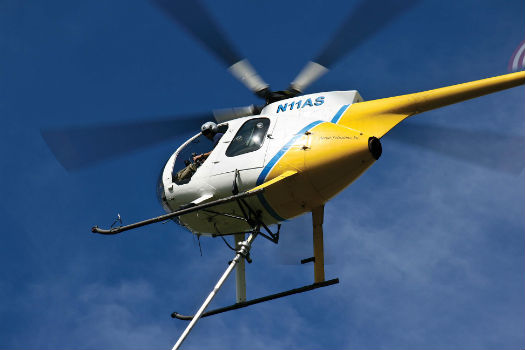
Vegetation control work by helicopter is grueling for both the aircraft and the pilot. The helicopter is serviced under a comprehensive maintenance program, while the pilots each have their own way of dealing with the fatigue of flying in this one seating position all day.
“You want to do what with a helicopter?!” That was the reaction when William Cox first approached utility companies with his idea of how to clear trees and other vegetation surrounding power line and other utility right-of-ways. The year was 1985, and Cox had just founded Aerial Solutions, Inc. (ASI) and purchased the patent for an aerial saw (designed by Randall Rogers) that was still in the concept phase.
Rogers’ idea was essentially to suspend an enormous saw below a helicopter. Guided by precision flying, it would be able to access areas around a power line that would otherwise be too difficult or tight to reach, and clear the surrounding vegetation.
The original idea may have seemed a little bizarre when it was first pitched 30 years ago, but the operation quickly proved a hit when it was put into practice. Today, aerial saws carried by ASI’s fleet of 10 aircraft can be seen performing their highly-skilled work right across the eastern half of the United States, for a client base that includes approximately 20 utility companies.
The present saw assembly is 20 feet long, consisting of 10 blades of 24-inch diameter. The blades are attached to a square beam that houses the drive components — and it’s all powered by a gas engine located at the top of the beam.
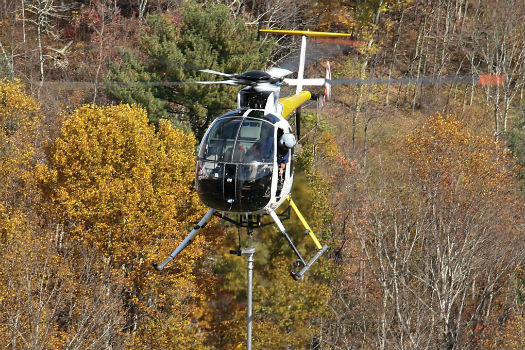
The pilots readily admit that if the engine or drive system were to fail, there is very little they could do other than try to aim for the softest landing spot. This is why Aerial Solutions’ maintenance program is so extensive.
The saw system is suspended below the helicopter on multiple sections of aluminum pipe that can extend as much as 80 feet. The pipe is mounted to the aircraft via a special frame assembly attached at multiple hard points, and it carries the control cables from the cockpit to the saw, as well as serving to keep the saw stable and prevent twisting.
The piping is flexible enough to act as a buffer, protecting the helicopter from the saw’s jolts as it makes its way through the debris below. Should there be a need to release the saw system — a rare event usually caused by a hang up or a jam in a tree — there is a quick release control in the cockpit that detaches the 800-pound system from its mount. Indeed, safety considerations are first and foremost throughout the company’s operations — reflected in fact that over its 30 years and more than 120,000 hours of flight, it has not had a single incident caused by a pilot, a maintenance issue, or a saw.
Learning the Ropes
Based in Tabor City, N.C., ASI’s operations began with a single Hughes (now MD) 500C. The current fleet of 10 includes eight MD 500Ds, one MD500E, and ASI also has a C model that is dedicated to a right-of-way patrol contract. One of the D models is a dedicated spare that is always saw-ready.
ASI claims that one hour of its tree-clearing work can save three hours of ground crews doing the same task, and, as Vertical visited ASI on location at a jobsite last fall in the Appalachian Mountains, west of Roanoke, Va., it was easy to see how this could be the case.
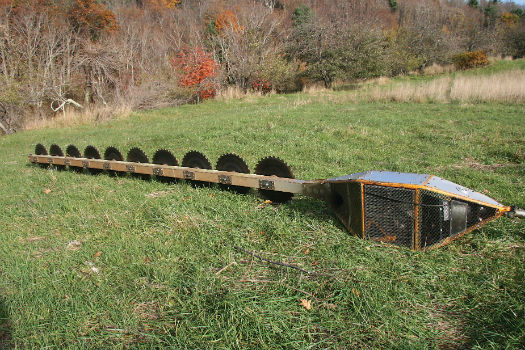
The 800-pound saw system consists of 10 24-inch blades mounted on a 20-foot shaft, powered by a small gas motor at the top of the assembly.
Using small hover turns to aim the aerial saw, pilot Curtis Martin dropped it into a densely-packed space surrounding a stretch of power line. He then combined gentle forward and backward movements as he raised and lowered the saw, cutting through the ends of the trees in the same manner one uses to clear scrub with a chainsaw.
The saw can run for about one and a half hours on the four gallons of fuel in its tank, so a typical cutting cycle usually lasts for around one hour and 15 minutes. Back at the landing zone, Martin set the saw down like one would lay a newborn into a crib. But with a rigid connection to the saw instead of long, flexible line, he had to back-up as he descended — reminiscent of the fun-park rides where the little helicopters raise and lower on a beam.
The fluidity of the aircraft’s movements throughout the operation mask the challenges faced by the pilot. “Every situation is different,” Martin told Vertical. “You’re always considering the external load, the wind, how the limbs will fall, and how to deal with overhanging branches. No two situations are the same.”

The saw system mounting hardware includes a quick-release as a last resort for emergencies, or if the saw snags in a tree.
ASI has 15 pilots, and the training program is understandably extensive. For new applicants, it likes to see 1,500 hours as pilot in command in helicopters, although none of that has to be turbine time. (A turbine transition is included in the company training program regardless of the applicant’s turbine experience.) What ASI is looking for is the total package.
Applicants are screened on personality, safety attitude, and their ability to manage a job. After all, the pilot is placed out into the field with only the ground support person. The two of them are an island, responsible for everything from safety and productivity, to client and tree crew communications.
The interview process alone runs from two to three days. New pilots spend six weeks just learning to fly the saw in ASI’s local training ground, then six months to a year in the field working with an experienced saw pilot, who coaches over the radio.

It takes presicion flying to maneuver the 20-foot saw system — mounted on as much as 80 feet of aluminum pipe — in the tight spaces between the vegetation and the power lines they threaten.
One would think long-line experience would help, and it sometimes does. But as Ted McAllister, ASI’s general manager, indicated, “Not all experienced long-line pilots make good saw pilots. We’ve had some long-line guys drop out early, while some without the experience caught on right away.”
ASI pilots also undergo annual recurrent training. It begins with a day or so in the classroom, followed by a week of flying.
Martin is a pilot who demonstrates ASI’s sincerity about the total package — and the commitment to continuing the family culture that was established 30 years ago. Martin came to ASI six years ago as a ground crewman, at which point he only had a fixed-wing license. During his off-hitch time, he obtained his helicopter add-on rating and built up his hours. Then, in January 2010, with 500 hours under his belt, he picked up his first saw — and he’s been flying it ever since. With ASI pilots averaging 500 to 600 hours per year, Martin now has over 3,000 hours.
ASI conducts “tailgate safety sessions” with the tree companies it contracts to protect the working areas and clean up the debris (where required). They cover issues such as radio procedures, road flagging, dealing with area homeowners and farmers, and ensuring that ground crews and spectators will be kept back so they don’t get hit with flying tree limbs. “These procedures are reinforced daily,” said Martin.
He admitted that the nature of the company’s operations meant that an engine failure would be a major problem. “It’s the nature of where we fly — right in the curve,” he said. “There really is no time to do anything except aim for the softest tree. This is why our maintenance program is so intensive.”
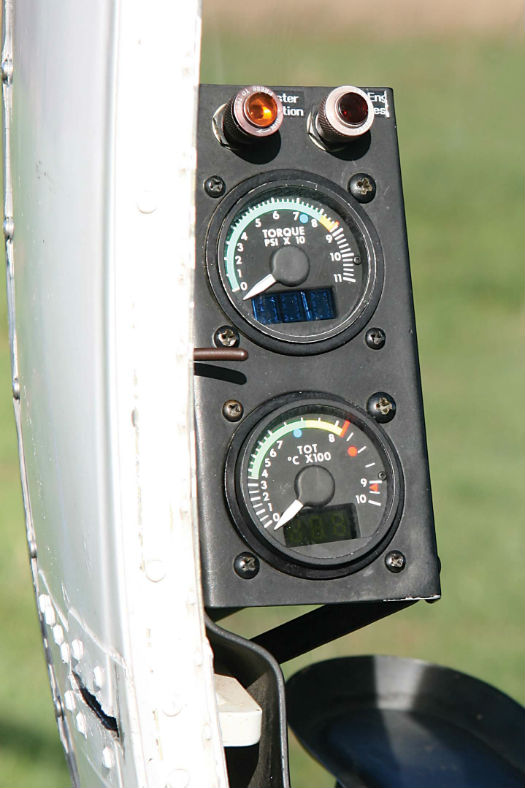
Diamond J Torque and TOT gauges are mounted on the pilot’s door frame for easy line-of-sight monitoring while the pilot is “heads-out” operating the saw.
Above and Beyond
ASI has five mechanics — four of them are rovers, with the fifth being the director of maintenance who stays at the ASI base.
ASI’s maintenance practices are above and beyond the requirements of the United States Federal Aviation Administration and the original equipment manufacturers, with each aircraft completely refurbished every seven to eight years. The ships are stripped right down to the bare metal and rewired, before new or overhauled components are reinstalled. The company keeps a tight watch on components and doesn’t try to push them to the limit. The Rolls-Royce Model 250-C20B engines are the enhanced turbines, allowing for more efficient temperature control — and they all have Donaldson air filters.
The ASI ships have Diamond J digital torque and turbine outlet temperature gauges, mounted on the pilot’s door frame for easy viewing during saw operations. A tone generator warns the pilot anytime he or she gets close to a limit. The data from the gauges is recorded, and the pilot check is required to check them after each flight. The mechanics download the data every 100 hours.
The aircraft are not flown at maximum gross weight, and where weight, altitude and temperature are more critical, the crews will reduce the fuel loading while adhering to the company minimum of landing with at least 100 pounds on board.
Finally, as well as performing daily power checks, ASI tracks engine performance. Scheduled maintenance usually takes place in the field, with ASI renting hangar space at an airport near the jobsite. For heavy maintenance, the helicopters are ferried back to Tabor City.
The saw has its own in-house design and manufacturing division, and it is the subject of constant change and improvements. The original saw adapted by ASI was hydraulically powered and very heavy. Accordingly, that design didn’t last long before it was changed to a drive system powered by a gas engine that was lighter and more efficient.

The ground support rig is an all-in-one office, GPS and cell phone booster, storage facility, saw transport, lunch counter, and refueling station for the helicopter and saw.
“In the early days, the saw was maintenance intensive,” said William’s son, Cleve Cox, who is now at the helm as ASI’s president and chief pilot. “Many changes have been made to the drive system. Over time, the saw became much more efficient, reliable, and now causes very little down time.”
Out in the field, each aircraft has its own ground support rig. This multi-purpose vehicle functions as a mobile office, lunch counter, GPS and cellphone booster, as well as a storage facility for spare saw parts, tools, safety equipment and spill kits. The rig carries 500 gallons of Jet-A fuel, 50 gallons of water for cleaning the helicopter, and fuel for the saw’s gas motor. It also has a small crane that lifts the saw on and off the rig for transport to the next job.
Logistical Challenges
As if the flying isn’t difficult enough, the logistics and environmental considerations for conducting such an operation are extensive. The wildlife cycles of creatures such as owls or Indiana brown bats need to be worked around, and the jobsites can be in environmentally sensitive areas in which ground crews are only allowed in an emergency. And this is just the tip of the logistical challenges.
To help make the operation go as smoothly as possible, ASI sends out a project coordinator months in advance of the anticipated start date. This coordinator meets with the power company to survey the job and study line maps. They make all the necessary local contacts, such as with the tree contractors (hired by the utility company, but coordinated by ASI) who will clean up the debris in the areas where this is necessary. They also contact all property owners within a certain range of the cutting sites so they aren’t taken by surprise when operations start.
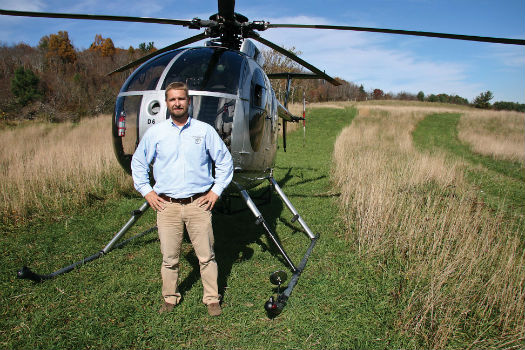
ASI’s president and chief pilot, Cleve Cox, is the son of company founder William Cox.
Another critical task is securing a landing zone for the operation’s base and making any arrangements necessary for that location. Although it’s not uncommon for local farmers or other large property owners to gladly offer up some of their land for the landing zone, consideration still must be given for adequate size, level ground, absence of power or phone lines, and avoiding interference either to or from livestock.
As part of the advance planning, ASI develops a detailed emergency action plan, coordinated with local emergency medical services and other first responders. Constant situational awareness is paramount for all entities involved in the process.
The commitment to safety is reflected in the fact that the pilots clearly have full decision-making control. During casual conversation, McAllister stated that, due to winds and weather, they recently spent a week in a hotel on location to get just four hours of flying in. “Our customers understand and respect pilot decision making,” he said. “But that comes from ASI’s coaching regarding our safety culture. Helping the customer manage expectations is key.”
Indeed, the lifestyle for the field crews is definitely one of hotel living. The pilots and ground crew members work together on a 28-days-on, 28-days-off cycle, with Sundays off. ASI crews rotate the hitch schedule each year to swap holidays off. The company completely shuts down from mid-December to the new year.

The distances between the helicopter staging areas and the work areas are usually short, thus providing for minimum ferry time.
“To make myself feel better, I call it being semi-retired,” said Martin with a smile. “On week one, it’s all about getting back in the game. On week two, that’s when you feel like you’re at the top of your game. Week three starts the second half; you’re still on your game, but not at the end yet. Then week four brings additional tasks — like paperwork and reports — and that is renewing because it signals the hitch is soon to end.”
Martin must enjoy it. He indicated he has no intention of leaving ASI. The pay allows him to support his wife and kids on their own farm. “ASI has been too good to me,” he said. “I love the people and the schedule and I have a very supportive wife. It really is like a family.”
Flying the saw is risky work that is tough on the crews and equipment. But ASI has figured out the formula to mitigate the risk as much as they can, while keeping their clients and employees happy.
It’s a formula that has served the company well for the last 30 years, and, according to Cleve Cox, it has no intention of changing a winning formula. “We will hold to the same philosophy we’ve maintained all of these years: Be the best at safely meeting the needs of our customers, while keeping that personal touch,” he said. “Flying the saw is what we know, [and] we will stick to doing that one thing best.”






Hi: Fascinating piece of equipment. Are the blades driven by gears or chain?